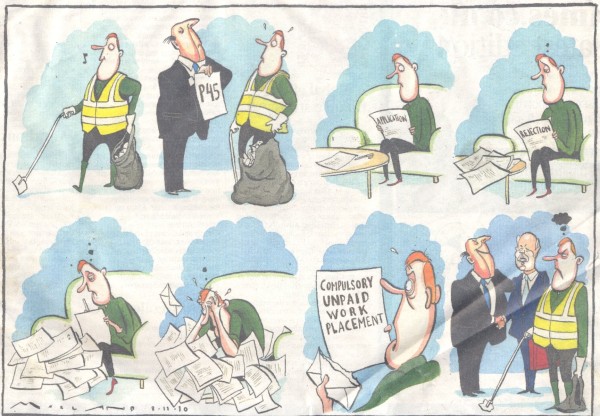Workfare replaces paid jobs with unpaid labour
“Did you know we could offer you free, temporary staff for four weeks?”
- Previous advertising material from JHP Employability.
“After the 6 weeks were up the manager asked him if he would like to stay on for some extra weeks, my friend asked ‘with pay’? The manager said why would he pay him when he can pick the phone up and get more unemployed people who have to work for nothing”
- Comment on Guardian CIF about a work placement with Tesco
“Stores such as Argos, Asda, Superdrug and Shoezone made use of the government’s workfare schemes to meet their seasonal demand, instead of hiring extra staff or offering overtime.”
Workfare keeps wages down for those still in jobs.
“It’s obvious that workfare workers are replacing paid jobs – pushing our low-wage economy down towards a no-wage economy.”
Workfare is literally worse than useless
“5 per cent of long-term unemployed can be expected to find jobs for six months if left alone to do so.
Successful six month employment rate during the first year of the Work Programme was just 2.3 per cent, significantly below the target of 5.5 per cent.”
- Telegraph: Iain Duncan Smith’s Work Programme ‘worse than doing nothing’ (The Work Programme includes work placements.)
Workfare subsidises big business
Instead of paying wages that contribute taxes and spending back into the economy, big companies like Tesco and Poundland benefit from free labour while continuing to keep the workers reliant on benefits at our expense. That money goes straight into shareholder’s profits.
Workfare does not provide the training that it is meant to
Work experience schemes are meant to provide training for future jobs. Instead we have people with extensive education toward a chosen career being sent to stack shelves and sweep floors which does not further them in the career they have trained for at all. Even when a person expects to find work in retail, four weeks experience in shelf stacking is hardly a necessity to do the job in future. In most cases little or no training is being given and the work placement consists only of manual labour.
Workfare exploits sick and disabled people
People who receive Employment Support Allowance and are placed in the Work Related Activity Group can be sent on The Work Programme or Mandatory Work Activity. Charities such as Sue Ryder, The Conservation Volunteers and The Salvation Army are fully aware of that, even enthusiastic, although TCV has now announced it will not force people on ESA to volunteer(!) and Sue Ryder has pulled out altogether.
“How can we morally take sick and disabled people and force them to work?
At The Salvation Army, we have a history of believing in emancipation through employment. People who come for work experience with us are fully supported throughout their placements with help tailored support to their needs.”
- The Salvation Army, in a comment on Facebook
“Arbeit Mach Frei”
Workfare is costing poor people money they don’t have
People sent on work schemes are having to pay for transport to get there without any extra income. Sick and disabled people are often being hit particularly hard by transport costs as they are too sick to use the bus or train and end up paying for taxis to avoid having their benefits cut.
Workfare is damaging the health of sick and disabled people
People in the Work Related Activity Group on Employment Support Allowance are not fit for work, they are considered to potentially be fit for work at some unknown point in the next few years. And yet they can be sent to work nearly full time (30 hours) for several weeks. Of course it’s going to damage their health.
Workfare doesn’t create new jobs, only changes who might be in a job.
If there aren’t any jobs being created then all workfare does is give the employer weeks of free labour from one or more people before they employ someone, if they even need to.
Workfare doesn’t pay wages
“A fair day’s wages for a fair day’s work”


